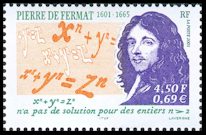Pierre de Fermat (1601-1665)

The mathematician Pierre de Fermat was born in Beaumont-de-Lomagne, France, the son of a leather merchant. Like Pascal, he was educated at home. He worked for most of his life as a councillor for the local parliament in Toulouse, and led a fairly quiet life. He published very little during his lifetime, and much of his work was found after his death on loose sheets of paper or written in the margins of books he had read.
Fermat made important contributions to probability and number
theory, and anticipated some results of differential calculus.
He is most famous for a conjecture known as "Fermat's last
theorem", which states that the equation
To learn more about Fermat's work, see A Short Account of the History of Mathematics by W. W. Rouse Ball.